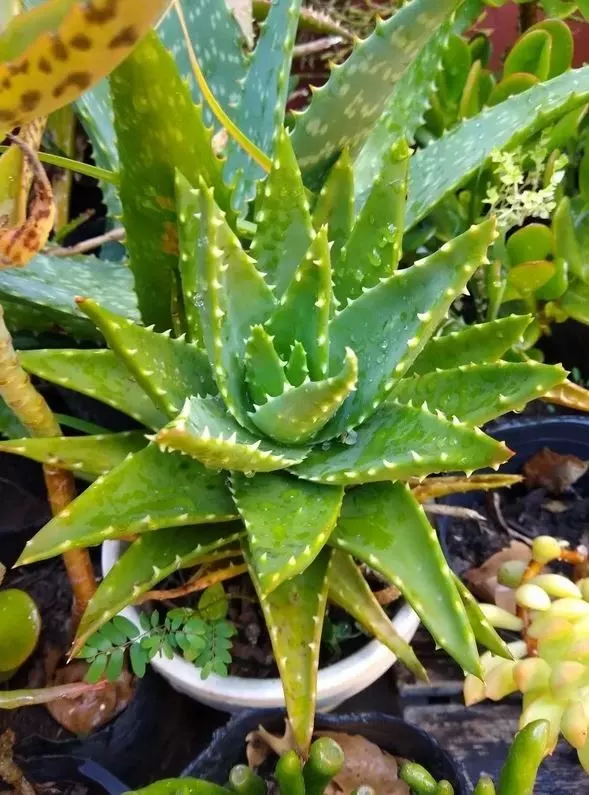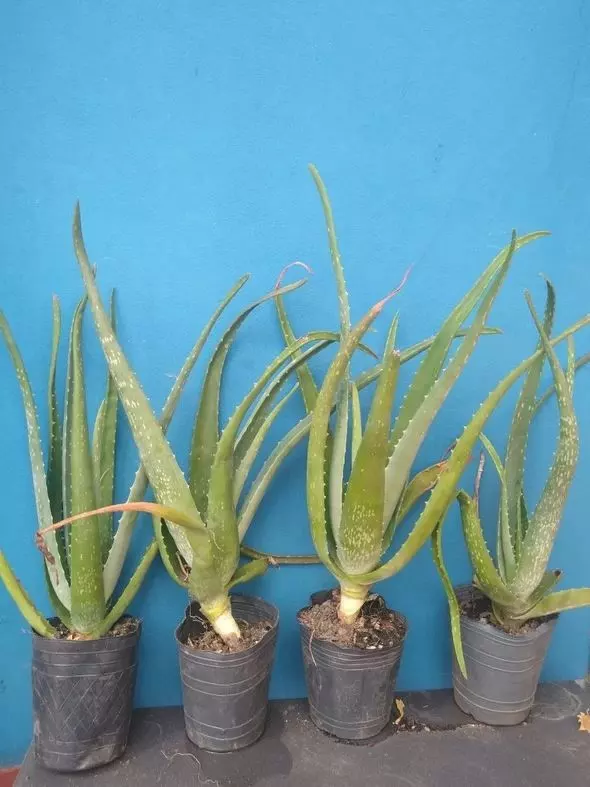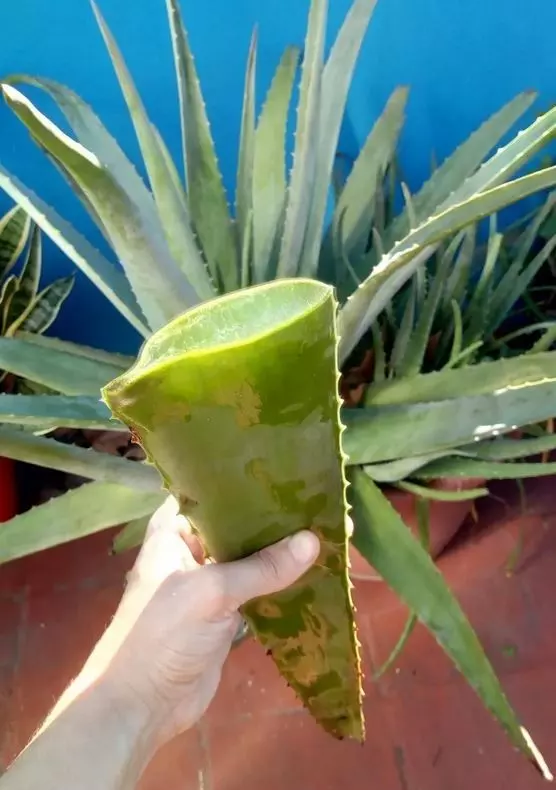This variety of aloe is the best known of all the existing aloes, not only for its medicinal properties but also for being a plant of easy maintenance and beauty. It is bright green with small light spots and like most aloes, it has spikes on the outer edges of its leaves. Learn all about Aloe barbadensis miller care and propagation in this article. Also, we will review Aloe barbadensis miller benefits.
There are more than 500 species of the Aloe genus, being Aloe barbadensis miller, the scientific name of Aloe vera, which belongs to the Liliaceae family.
Due to the incredible properties and health benefits of Aloe barbadensis miller, together with the ease of cultivation, Aloe Vera production has spread worldwide.
Aloe barbadensis miller grows as a shrub and is a perennial plant. Aloe barbadensis miller accumulates water in its leaves, being this capacity that characterizes it as a succulent plant and allows it to survive easily in dry climates and high temperatures.
Aloe barbadensis miller leaves are green, triangular, and with serrated edges, which simulate teeth or thorns. As I said before, it is believed that the Aloe barbadensis miller is native to Africa but today it is found in any warm region of the world. In addition, it is an ornamental plant easy to cultivate indoors and outdoors.

Table of Contents
Aloe barbadensis miller (Aloe Vera)
The scientific name of Aloe vera is Aloe barbadensis miller. Even Aloe vera is the common name of this succulent plant. Aloe vera receives many names depending on the geographical area where we are. From Aloe vera in Latin America, Aloe vera in European countries and Asia, as well as Aloe from Barbados or Aloe de Curacao in Brazil and Caribbean countries mostly.
The genus Aloe is native to Africa, Arabia, and Cape Verde, although Aloe barbadensis miller is most likely native to North and South Africa, to countries such as Morocco, Sudan, Egypt, and Mauritania.
Aloe barbadensis miller was introduced to Europe and China in the 17th century and its cultivation spread to many other parts of the world.
Today, Aloe barbadensis miller grows in several countries, but mainly in the tropical and temperate climate zones of Mexico, Paraguay, Nigeria, Belize, Australia, Barbados, Paraguay, and the United States. In the United States, Aloe barbadensis miller is cultivated mainly in Arizona, Texas, and Florida.
Aloe barbadensis miller is so easy to cultivate and requires so little maintenance that it grows and reproduces very easily. This is one of the main reasons why it has spread worldwide.
Aloe barbadensis miller Care & Grow
A quick look at Aloe barbadensis miller characteristics:
- This plant prefers to be in full sun or partial shade.
- Sensitive to prolonged extreme cold.
- Aloe barbadensis miller grows between 31” (80 cm) and 40” (1 m) tall. Same width measurements.
- Can be grown indoors if given sufficient light.
- It is propagated by offshoots, but also by seeds and cuttings.
- It prefers hot and dry climates. Resistant to cold. Withstands up to 19.4 °F (-7ºC).
- It is not toxic to humans but can be toxic to some animals.
Aloe barbadensis miller Care and Propagation
This Aloe is one of the most common succulents in the world. Most probably you have one at home or you have seen it in a friend’s house.
Let’s start reviewing Aloe barbadensis miller Care Tips.
Aloe barbadensis miller Care
Aloe barbadensis miller Watering
Aloe barbadensis miller Watering. This Aloe plant tends to need a little less water than other Aloe plants because it has more capacity to store it in the leaves.
Therefore, we must let the soil dry out before watering Aloe barbadensis miller again. This is why this plant is easily cultivated in geographic areas with dry and hot climates such as Arizona.
Where is the Best Location for Aloe barbadensis miller Care?
Where is the Best Location for Aloe barbadensis miller Care? This Aloe plant is not resistant to extreme cold.
So, if you live in an area that gets colder than 19.4 °F (-7°C), it is best to plant Aloe barbadensis miller in a container that can be brought inside, indoors. It works well in full or partial sun.
If in the grown, plant your Aloe barbadensis miller in an area of your garden that receives 6 hours of sunlight per day.
If it is a potted Aloe barbadensis miller plant located indoors, place it in a room that receives plenty of sunlight, such as near a south-facing window (if you’re in the northern hemisphere).

If it is a potted Aloe barbadensis miller plant located indoors, place it in a room that receives plenty of sunlight, such as near a south-facing window (if you’re in the northern hemisphere).
More Aloe barbadensis miller Care Tips
A few more Aloe barbadensis miller Care Tips. Aloe barbadensis miller needs some annual trimming to grow and develop healthily. Learn more about How to Trim an Aloe Plant Step by Step.
Aloe barbadensis miller Propagation
Aloe barbadensis miller Propagation. Aloe barbadensis miller is a very prolific plant, developing many offspring around the base of the plant when it reaches maturity.
In theory, the Aloe barbadensis miller plant can be propagated from leaves by burying them directly in the ground, as well as by seeds. However, the most effective and quickest way is from the offspring.

Aloe barbadensis miller Seedlings
How to Propagate Aloe barbadensis miller? Aloe barbadensis miller produce small offshoots, sprouting around the base of the plant. Simply cut them off (try to have roots) and allow the offshoots to dry for a day or two before repotting.
- Live Aloe Vera Plant
- Live Indoor Houseplant
- 4'' Diameter, Approx 8'' Tall
Aloe barbadensis miller Benefits
Aloe barbadensis miller Uses and Properties. Aloe barbadensis miller plant can be used in many ways. In the case of minor burns or cuts, you can cut or break a leaf and squeeze the gel inside, rubbing it on the affected area, it can also be ingested for other health problems.
Aloe barbadensis miller Benefits. According to a recent scientific study, oral Aloe barbadensis miller treatment to mice improves wound healing, reduces the number and size of papillomas, and reduces the incidence of tumors and Leishmania parasitemia in the liver, spleen, and bone marrow by more than 90%.
The same scientific study suggest, Aloe vera used topically is ineffective in preventing radiation-induced lesions and offers no protection against sunburn or tanning. Genital herpes, psoriasis, human papillomavirus, seborrheic dermatitis, aphthous stomatitis, xerosis, lichen planus, frostbite, burns, scarring, and inflammation are among conditions that it can help with. It can also be employed as a biological carrier, antibacterial, and antifungal agent, as well as a candidate for cancer photodynamic treatment.
Although there have been some encouraging outcomes with the Aloe barbadensis miller plant for various dermatological disorders, the therapeutic effectiveness of oral and topical aloe vera has yet to be thoroughly investigated.
Note: Always consult a physician before ingesting any plant. Although Aloe Vera is generally considered non-toxic, some people may experience adverse reactions.


